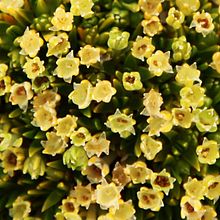Antarctic pearlwort
| Antarctic pearlwort | ||||||||||||
|---|---|---|---|---|---|---|---|---|---|---|---|---|

Antarctic pearlwort |
||||||||||||
| Systematics | ||||||||||||
|
||||||||||||
| Scientific name | ||||||||||||
| Colobanthus quitensis | ||||||||||||
| ( Kunth ) Bartl. |
The Antarctic pearlwort ( Colobanthus quitensis ) is a species of the genus Colobanthus within the carnation family (Caryophyllaceae). Contrary to what its German name suggests, it is not only found on the Antarctic continent , but also from Chile and Peru to Patagonia and on some sub-Antarctic islands .
description
Vegetative characteristics
The Antarctic pearlwort is a cushion-forming and bare, small, very variable in size, tufted plant with strong roots. The leaves are in a rosette. The grass-like, stiff or soft leaves are linear with a length of 1 to 1.5 centimeters, but occasionally also longer.
Generative characteristics
Their slender inflorescences are as long as the plants themselves or a little longer and have a single terminal flower on a short flower stalk that is thickened at the top. Bracts can appear on the inflorescence or pedicel.
The four or five sepals are egg-shaped to oblong-round and tapering to a point, the same number of stamens are alternate to the sepals. The capsule fruit protrudes from the calyx. The seeds are reddish with a long funiculus .
distribution
The distribution area of the Antarctic Pearlwort is extensive. It stretches from Mexico (17 ° N) over the South American Andes to Patagonia . Sub-Antarctic it stretches across the Falkland Islands , South Georgia , the South Orkney Islands and South Shetland Islands to the Antarctic Peninsula . There it is limited to the ice-free areas of the western coastal region, where it colonizes well-drained, mineral clay soils, presumably due to the increasingly higher temperatures in the Antarctic summer, its range there is gradually increasing.
The Antarctic Perlwurz is next to the Antarctic Schmiele ( Deschampsia antarctica ) the only native seed plant of the Antarctic flora kingdom , with it (as well as the neophytes annual bluegrass and meadow bluegrass ) it forms the only seed plant vegetation type there, the "grass and cushion plant subformation" . The Antarctic pearlwort is the rarer of the two native species; of 116 vascular plant locations known there in 1985, it was found in 42%, and only in 3% it occurred alone.
As a plant that is adapted to both alpine and polar conditions, it can be found at very different altitudes depending on the location. In the Antarctic it is found near sea level, but in the Andes it rises up to 4200 meters.
Taxonomy
It was first described under the name ( Basionym ) Sagina quitensis by Karl Sigismund Kunth in the first half of the 19th century. The specific epithet refers to the site near Quito , the Ecuadorian capital. Friedrich Gottlieb Bartling placed it in its own genus in 1831, Colobanthus , of which it is a type . Another synonym for Colobanthus quitensis (Kunth) Bartl. is Colobanthus crassifolius (d'Urv.) Hook.f.
Individual evidence
- ↑ a b c d Karl Reiche: Estudios críticos de la Flora de Chile , 1896 ff., Volume 1, p. 189 ( PDF Online ; 410 kB).
- ^ A b c J. Francis Macbride: Flora of Peru - Caryophyllaceae In: Fieldiana. Botany series , Volume 13, II, No. 2, 1937, p. 578.
- ↑ a b Angela Sierra-Almeida et al .: Photosynthetic responses to temperature and light of Antarctic and Andean populations of Colobanthus quitensis (Caryophyllaceae). In: Revista chilena de historia natural , Volume 80, Issue 3, 2007, pp. 335-343. ISSN 0716-078X .
- ↑ a b Vera Komárková, Sally Poncet, Jérôme Poncet: Two Native Antarctic Vascular Plants, Deschampsia antarctica and Colobanthus quitensis: A New Southernmost Locality and Other Localities in the Antarctic Peninsula Area. In: Arctic and Alpine Research , Volume 17, No. 4, 1985, pp. 401-416.
- ↑ Carl W. Grobe, Christopher T. Ruhland, Thomas A. Day: A New Population of Colobanthus quitensis near Arthur Harbor, Antarctica: Correlating Recruitment with Warmer Summer Temperatures. In: Arctic and Alpine Research , Volume 29, No. 2, 1997, pp. 217-221.
- ^ RE Longton: Vegetation in the Maritime Antarctic. In: Philosophical Transactions of the Royal Society of London. Series B, Biological Sciences, Volume 252, No. 777, A Discussion on the Terrestrial Antarctic Ecosystem , 1967, p. 223.

